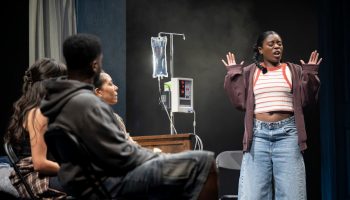
Julia Weber
Staff writer
What do you think of when you think of home?
Maybe it’s artful decor, comforting furniture passed down through generations, a sense of community, love.
In Chautauqua Visual Arts’ “Crafting Home,” curated by Associate Director of CVA Galleries Erika Diamond, art objects of domesticity occupy the gallery and explore meanings of home through functional objects, handcrafted artworks and, most of all, labors of love.
With more than 30 artists’ work coming together to pay homage to the spaces we call home, the exhibition — on view now through Aug. 3 at Fowler-Kellogg Art Center — is a powerful exploration of the intersection of form and function across mediums.
Yoko Sekino-Bove, a potter, uses her decorated vessels to find commonality between the artist and viewers. She uses animals as a universal motif, with the hope that people can see themselves in her work — transcending any specific identity that may divide them. Adorned with these animals, Sekino-Bove’s pots depict scenes of community and interpersonal relationships through which she explores intrinsically human experiences.
“We still feel the same way, and we have the same thing because we share the same emotions together,” she said. “I started making that series more than 10 years ago, and since then, I personally hope that my work (has) become relevant. It seems like it’s needed more than ever for us to remind ourselves that we’re still on the same boat, feeling the same way, eating the same way, having a life and everyone just wants to be happy and exchange fun stories together.”

While Sekino-Bove most often makes functional work, the main goal of her art isn’t to act as a utilitarian object but rather to tell a story and elicit emotion from viewers.
“Through my work, I’m trying to provide or deliver the joy and the excitement using clay as my medium. Function is not necessarily my goal to achieve but … more like a surprise and entertainment that I want to share with people,” she said.
Metalworker Sachi Nasatir’s lamps act similarly, combining form and function to enhance living spaces and elevate what are sometimes viewed as strictly utilitarian objects.
“They’re specifically pieces that are supposed to enhance the room and (are) meant to both add to the aesthetic of the space as well as create better viewing for everything else in it,” said Nasatir.
Nasatir said they hoped to surpass the functional aspect of the lamp in the design process by elevating the object to make it not just an object of purpose, but an object of beauty in its own right.
“I was trying to take a new approach to creating an object that functions as a lamp does in any sort of home or space, but also elevates the different ways in which you can create those shapes or take it to another level,” said Nasatir.
In contrast, Carly Owens Weiss, a sculptor and painter, renders functional objects nonfunctional by recreating personal objects out of beadwork and textiles.

“It was used to beautify the home, but I’m using it to create objects that are representative of things that should be functional, yet they aren’t,” she said. “I like creating these faithful representations of recognizable objects if they are rendered totally useless.”
Owens Weiss works in soft sculpture draw attention to how the body acts as a home, protecting and nourishing the soul through corporeal shelter.
“I often reference the body as a home itself, so even though I’m not directly creating functional objects to be used within a home, they are objects that mirror what would exist in one in the context of the body,” she said.
Sekino-Bove recently led a workshop at the Institution as part of CVA’s programming, and she freely shares her glaze recipes and process online. For her, sharing these resources is a way to foster art by giving back to others.
“I love to share what I’ve learned because those are the things that other people gave me, and I feel like this is my time to give it to the next generations,” she said.
She added that while some artists take their trade secrets or recipes to the grave, she doesn’t — because to her, what makes her art unique isn’t the materiality but the content.
“(Heritage) is an important part of craft practice to survive for any person, but at the same time, I happen to be in the position that I can share those technical informations with them because I think the uniqueness of my artwork comes from the story I tell to people, not by the glaze or construction technique or secret ingredient,” Sekino-Bove said.

Though the intricacies of each piece in the exhibition vary, the relationship between home and self is strong.
Nasatir pointed out how historical recreations of domestic spaces have been used to identify how household objects can exemplify artistic qualities and said they view this exhibition as an exciting extension of those recreations.
“It’s really interesting because you go to museums and institutions all the time that remake rooms for very specifically certain areas — historical remakes — and it’s nice to see something that’s expanding on that,” said Nasatir.
Sekino-Bove said she hopes Chautauquans who see the exhibition will follow their curiosity and intellect to explore different ideas and possibilities about how they can establish their own identities through the objects that surround them.
“I’m really honored that my pieces had a chance to be presented with other artists to suggest or indicate to people how it could be done, the fun of orchestrations and assemblage and coming up with a unique home space for someone,” Sekino-Bove said. “I think it’s a lovely idea. Instead of each individual work specifically in the category of this craft or this medium, I’m hoping that (this exhibition) will inspire people to think about how they can start combining different works to establish their own styles and identities.”




